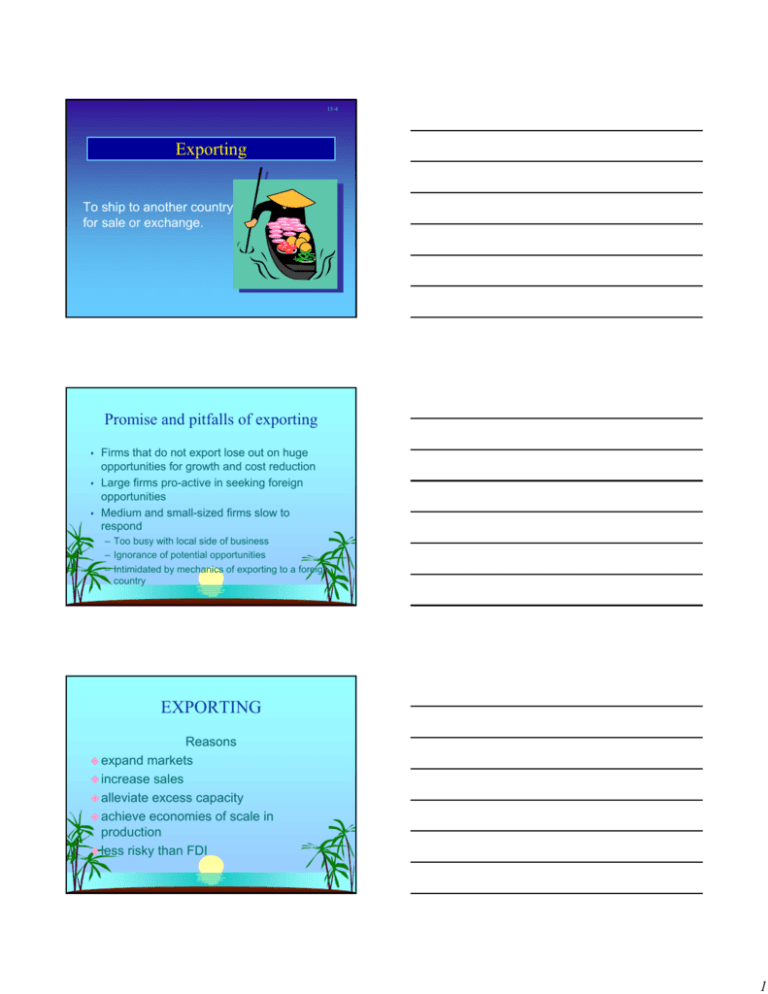
15-4
Exporting
To ship to another country
for sale or exchange.
McGraw-Hill/Irwin
© 2003 The McGraw-Hill Companies, Inc., All Rights Reserved.
Promise and pitfalls of exporting
Firms that do not export lose out on huge
opportunities for growth and cost reduction
Large firms pro-active in seeking foreign
opportunities
Medium and small-sized firms slow to
respond
– Too busy with local side of business
– Ignorance of potential opportunities
– Intimidated by mechanics of exporting to a foreign
country
EXPORTING
Reasons
expand markets
increase sales
alleviate excess capacity
achieve economies of scale in
production
less risky than FDI
1
DIRECT EXPORTING
Sales representative
Agents
Foreign distributors/retailers
Export department
Manufacturer’s representative - handles
the non-competitive products of a
number of firms in a foreign market and
solicit domestic orders for foreign
manufacturers
INDIRECT EXPORTING
Export Management Company - firms that
buy merchandise from manufacturers for
international distribution
Export Trading Company - is a firm formed
by competitors that may engage in
various business practices and be
exempt from anti-trust laws
ETC Act (1982) authorizes the the
creation of ETCs to stimulate export from
small firms
Advantages of Indirect Selling
full scale program can be quickly
established
minimum financial commitment
minimum risk for manufacturer
experts working for you in developing
markets abroad
volume can be built up quickly
2
Disadvantages of Indirect Selling
manufacturer has no direct control over
the export of their products and
marketing
intermediaries may be distracted with
other products
firm does not develop its own int’l
expertise
intermediaries any drop product anytime
Improving export performance
Assistance available to firms for export
process
International comparison
Information sources
Export management companies
Exporting Strategy
International comparison
Biggest impediment to exporting is lack of
knowledge of the opportunities available
More than 200 countries with widely differing
cultures compose the world of export
opportunities
Overcome impediments by collecting
information
Japan:
Ministry of International Trade and
Industry (MITI) and trading houses (Sogo
shosha)
Evolve an institutional structure for promoting
exports
3
The role of government in the export/import
environment
Political
– Protecting jobs and industries
– National security
– Retaliation
Economic
– Develop/protect infant industry
– Strategic trade policy
First mover advantage
The ‘catch-up’ argument
US Export Support
www.doc.gov
www.ita.doc.gov
Information sources
U.S. Department of Commerce
– International Trade Administration
– United States and Foreign Commercial service
agency
– Provide “best prospects” list, “comparison
shopping service” & customized market research
survey for a small fee
– Organizes exhibitions at international trade fairs to
help potential exporters make foreign contacts and
explore export opportunities
– Matchmaker program
4
SOURCES OF EXPORT ASSISTANCE
U.S. Dept. of Commerce
World Traders Data Report - checks background of
foreign customer’s reputation, trade & credit
references, suitability as partner
Agent Distributor Service (ADS) - provides a custom
search for overseas agents or distributors thru 200
U.S. embassy and consulates
National Trade Data Bank (NTDB) -foreign
commercial information on CD-ROM and includes
Foreign Traders Index, Market Research Guide,
Export Statistics, Basic Guide, etc.
U. S. Dept. of Commerce
Basic Guide to Exporting - tips on methods
of payment, shipping, communications,
etc...
Advertising Service Through “Commercial
News” USA
Trade Opportunities Program - Commercial
officers in 65 countries offer investment
opportunities, leads on potential sales, etc...
Commercial Information Management System 3500 market research reports on market demand,
trade barriers, contacts, trade fairs, customer
profiles
Government Support for Exports
www.bundesregierung.de
www.miti.go.jp
5
EXPORT-IMPORT BANK (EXIM)
Lending Program - provides competitive,
low, fixed-interest rate financing to U.S.
exporters & foreign buyers of exports
Guarantee program - repayment
protection
Working Capital Guarantee Program small- and medium sized exporters obtain
financing for production & marketing
goods for sale abroad
Insurance - against political & commercial
risk of non-payment by foreign buyers
Export/Import Financing
15-11
Issue of TRUST
Letters of Credit (LOC)
– Bank guarantee on behalf of importer to exporter
assuring payment when exporter presents specified
documents
Drafts (Bill of Exchange)
– Written order exporter, telling an importer to pay a
specified amount of money at a specified time.
Bill of Lading
– Issued to exporter, by carrier. Serves as receipt,
contract and document of title.
McGraw-Hill/Irwin
© 2003 The McGraw-Hill Companies, Inc., All Rights Reserved.
Letter of credit
Issued by a bank at the request of the
importer
Bank pays a specified sum to a
beneficiary, normally the exporter, on
presentation of particular, specified
documents
Fee paid by importer for letter of credit
May reduce borrowing ability of
importer since the letter is a financial
liability
6
Draft (Bill of exchange)
Written by an exporter instructing an
importer to pay specified amount of money
at specified time
Required before the buyer can obtain the
merchandise
Two types
– Sight drafts - payable on presentation to
the drawee
– Time draft - negotiable instrument
allowing for delay in payment
Bill of lading
Issued to the exporter by the common carrier
transporting the merchandise
Serves three purposes:
– Receipt - merchandise described on document
has been received by carrier
– Contract - carrier is obligated to provide
transportation service in return for a certain charge
– Document of title – can be used to obtain payment
or a written promise before the merchandise is
released to the importer
A typical international
transaction
Fig 15.4
7
Pitfalls of Exporting
chasing orders from all over the world
instead of concentrating on few markets
neglect during booming domestic
markets
choice of overseas agents & distributors
no commitment from top management
not considering licensing or IJV instead
unwilling to modify products for foreign
markets
8


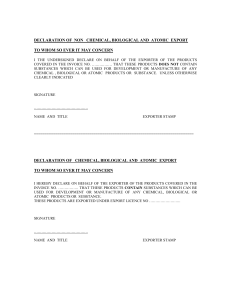



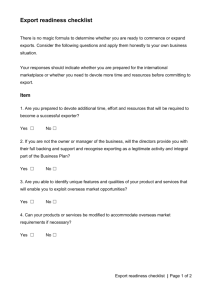
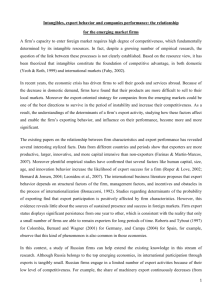

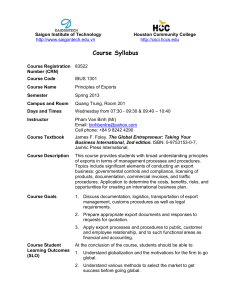
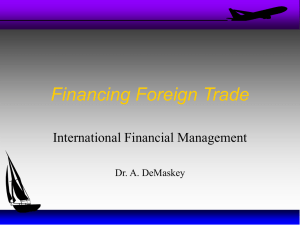
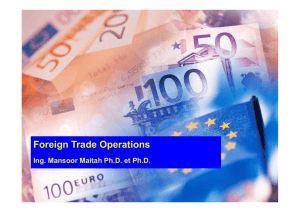
![International JV Checklist [LST]](http://s3.studylib.net/store/data/008453199_1-395cd66cfb1910c75e3dca0f22804658-300x300.png)